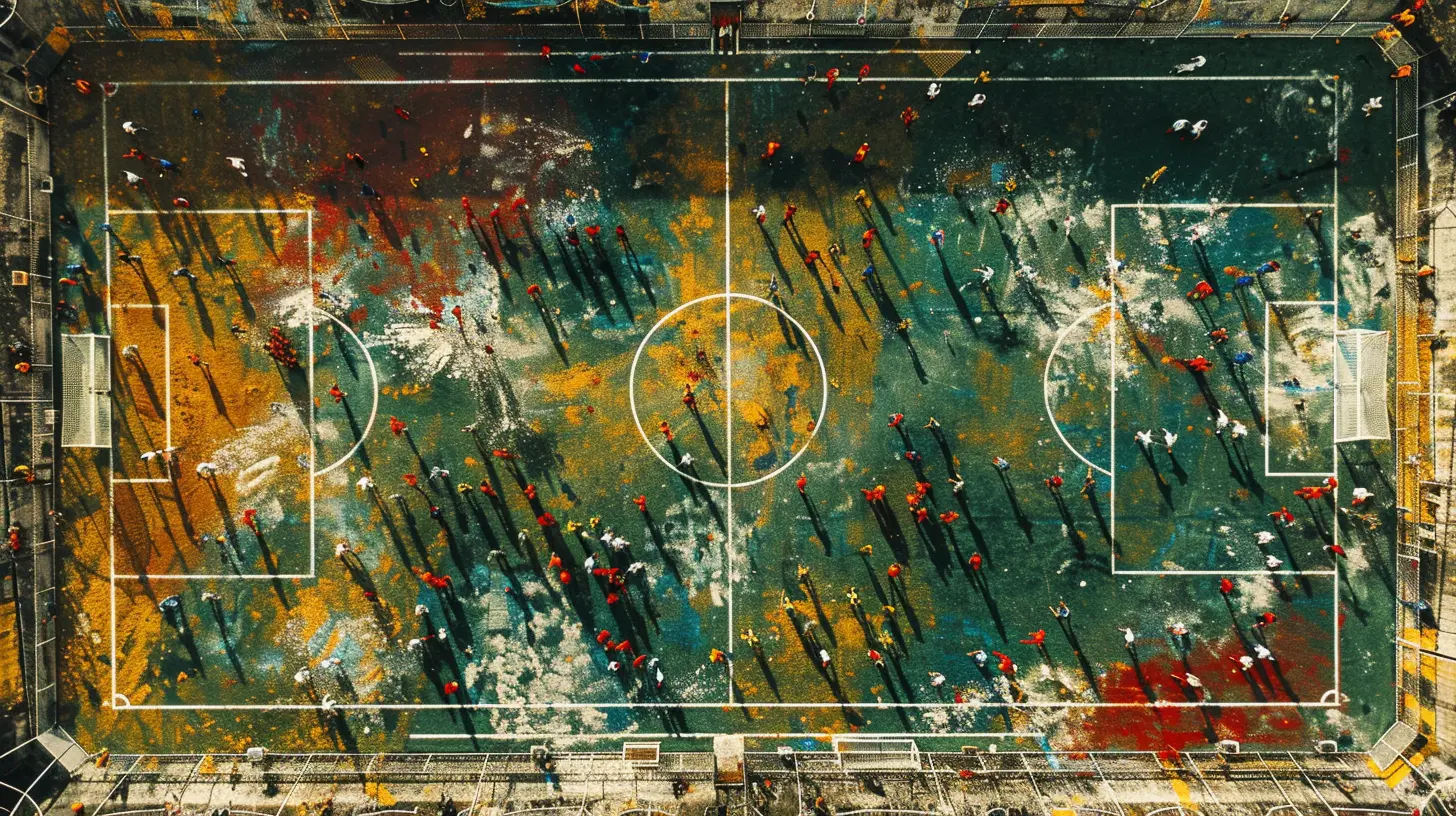Breaking Down the Tactics Behind the Latest Championship Clash
22 April 2025
When it comes to the world of sports, few things get fans more riled up than a high-stakes championship clash. It's the culmination of months, sometimes even years, of hard work, dedication, and strategy. But what really goes on behind the scenes? How do teams prepare for such monumental games? And more importantly, what specific tactics did the latest championship contenders use to tip the scales in their favor?
In this article, we're diving deep into the tactical brilliance behind the latest championship game. Whether you’re a seasoned fan or someone who's just getting into the nitty-gritty of game analysis, this breakdown will help you understand how small decisions on the field can make a world of difference. Let’s get started!

The Importance of Pre-Game Prep
Before a single whistle is blown, before any player steps onto the pitch, the battle often starts in the locker room and during practice sessions. Preparation is everything. Coaches and their teams spend countless hours analyzing their opponent’s strengths and weaknesses. They don’t just look at how well the other side attacks or defends. Oh no, they dive into the finer details—player tendencies, formations, set pieces, and even how well the opposition fares under pressure.In this particular championship clash, both teams were known for their meticulous preparation. You could almost feel the tension in the air beforehand as both sides had a clear game plan.
But preparation doesn’t just come from the coaching staff. The players themselves have to be mentally sharp. They need to know when to press, when to sit back, and when to break into space. It’s all a delicate balance.
The Role of Video Analysis
One of the unsung heroes of modern sports tactics is video analysis. Teams now have entire departments dedicated to breaking down hours upon hours of game footage. It’s like studying for the most important exam of your life, except the "exam" is 90 minutes long (or more, if we’re talking overtime).In this championship clash, both teams leaned heavily on this technology. They studied how their opponents played in the previous rounds, identifying patterns and weak spots. If a defender tends to drift too wide or a striker consistently makes the same run, you can bet that the opposition knew about it. And that’s where the tactical chess game begins.

Formations: The Framework of Tactics
When we think of tactics, formations are often the first thing that comes to mind. Why? Because formations provide the foundation for how a team operates on the field. In the latest championship clash, we saw two very different approaches.Team A's 4-3-3 Formation
Team A opted for the tried-and-tested 4-3-3 formation. This setup is all about balance. With four defenders, three midfielders, and three attackers, it allows teams to maintain control in the middle of the park while still having enough firepower up front.One of the key strengths of the 4-3-3 is its flexibility. The midfield trio can either sit back and protect the defense or push forward and support the attack, depending on the flow of the game. In this match, Team A's midfielders were crucial. They constantly shifted between defensive and offensive duties, ensuring that they never got overrun.
But what really stood out was how Team A utilized their wingers. Rather than sticking wide, the wingers would often cut inside, creating overloads in central areas. This forced Team B’s defenders to make tough choices: Do they follow the winger inside, leaving space on the flanks, or do they stay in their zones, risking a dangerous run through the middle?
Team B's 3-5-2 Formation
On the other side of the pitch, Team B went for a more unconventional 3-5-2 formation. This setup is often seen as more defensive, but in this match, Team B used it to great effect in both attack and defense.The three central defenders provided a solid backbone, but the real magic happened in the midfield. With five players in the middle, Team B was able to dominate possession and control the tempo of the game. Their wing-backs were given the freedom to bomb forward, essentially turning the formation into a 3-3-4 when they were on the attack.
One of the standout features of Team B's approach was their use of the "double pivot" in midfield. Two holding midfielders sat just in front of the defense, breaking up play and distributing the ball. This allowed the more creative players to push forward without worrying too much about getting caught out of position.

The Pressing Game: High Risk, High Reward
Pressing is one of the most talked-about tactics in modern football, and for good reason. A well-executed press can force the opposition into making mistakes, which can then be punished with quick counter-attacks. But pressing is also a high-risk strategy. If not done properly, it can leave huge gaps for the opposition to exploit.In this championship clash, both teams employed pressing tactics, but in very different ways.
Team A's High Press
Team A opted for a high press, meaning they pressured Team B’s defenders high up the pitch. This approach is all about disrupting the opposition’s build-up play, forcing them into making rushed decisions. Team A's forwards and midfielders worked tirelessly, closing down passing lanes and harrying the ball carrier.The high press worked wonders in the first half. Team B struggled to get out of their own half, and Team A created several goal-scoring opportunities by winning the ball in dangerous areas. However, the high press is incredibly demanding physically, and as the game wore on, Team A’s players began to tire. This allowed Team B to find more space and start building from the back.
Team B's Mid-Block Press
Team B, on the other hand, employed a more conservative mid-block press. Instead of pressing high up the pitch, they allowed Team A to have the ball in their own half, only engaging them once they crossed the halfway line. This approach is less physically demanding and allows the pressing team to stay more compact, reducing the space between their lines.The mid-block press proved to be a smart move as the game progressed. While it didn’t generate as many turnovers as Team A’s high press, it did make it difficult for Team A to find openings. And when Team A started to tire, Team B pounced, launching quick counter-attacks from deeper positions.

Set Pieces: The Hidden Game-Changers
Ah, set pieces. They’re often overlooked, but they can be absolute game-changers in tight matches. Corners, free kicks, and even throw-ins can provide opportunities to score or at least shift momentum.In this championship clash, set pieces played a pivotal role. Both teams had clearly worked on their routines, and it showed.
Team A's Corner Kick Strategy
Team A was particularly dangerous from corners. Rather than swinging the ball into the box aimlessly, they had a clear plan. The delivery was consistently aimed at the near post, where one of their tallest players would flick the ball on towards the back post. This created chaos in the box and led to several goal-scoring chances.But that wasn’t the only trick up their sleeve. On a few occasions, they used a short corner routine, pulling defenders out of position before delivering a cross. It was a clever tactic designed to disrupt Team B’s defensive organization.
Team B's Free Kick Mastery
On the other hand, Team B excelled at free kicks. They had a designated free-kick taker who could whip the ball into dangerous areas with pinpoint accuracy. But what stood out was their movement in the box. Rather than simply attacking the ball, Team B's players would make decoy runs, pulling defenders away from the area where the ball was being delivered.This movement caused confusion in Team A’s defense and nearly resulted in a goal on more than one occasion. It’s a perfect example of how something as simple as a well-rehearsed set piece can make all the difference in a tightly contested game.
Substitutions: The Final Tactical Twist
A championship clash is often decided in the final minutes, and that’s where substitutions come into play. Fresh legs can change the dynamic of a match, especially if the game has been a physical battle.In this match, both managers made key substitutions that impacted the flow of the game.
Team A's Attacking Change
As the game entered its final stages, Team A found themselves chasing the scoreline. Their manager brought on an extra attacker, switching from a 4-3-3 to a more aggressive 4-2-4 formation. The idea was simple: throw more bodies forward and overwhelm Team B’s defense.While the change did lead to a few half-chances, it also left Team A vulnerable at the back. And when Team B won the ball, they were able to counter-attack with devastating speed.
Team B's Defensive Shift
In contrast, Team B made a more defensive substitution, bringing on an additional defender and switching to a 5-4-1 formation. This allowed them to soak up pressure and protect their lead. With five defenders at the back, Team B made it incredibly difficult for Team A to break through.In the end, the tactical adjustments made by both teams in the final minutes showcased the importance of in-game management. It’s not just about starting the match with the right tactics; it’s about being able to adapt as the game evolves.
Conclusion: A Tactical Masterclass
The latest championship clash was a thrilling encounter, not just because of the drama on the field but because of the tactical battle that unfolded. Both teams came prepared with their game plans, and while they employed different strategies, it was clear that every decision—whether it was formations, pressing, set pieces, or substitutions—had a purpose.At the end of the day, tactics are what separate good teams from great ones. And in this match, we witnessed a tactical masterclass from both sides. The game wasn’t just about who had the better players; it was about who could outthink and outmaneuver their opponent.
all images in this post were generated using AI tools
Category:
Game AnalysisAuthor:

Frankie Bailey
Discussion
rate this article
7 comments
Caelum McGovern
This analysis highlights the tactical nuances of the championship match, emphasizing strategic formations, key player movements, and adaptive gameplay, ultimately revealing how these elements influenced the final outcome.
May 15, 2025 at 4:57 AM

Frankie Bailey
Thank you! I'm glad you found the analysis insightful—it really showcases how tactical decisions shape the game's outcome.
Laura Weber
Great analysis! I appreciate how you broke down the tactics. It’s fascinating to see how strategy plays such a crucial role in shaping the game’s outcome.
May 7, 2025 at 6:34 PM

Frankie Bailey
Thank you! I'm glad you found the analysis insightful. Strategy truly is key in determining outcomes.
Kova Henson
Intricate strategies unfolded in the championship clash, showcasing tactical brilliance on both sides. While one team finessed the offense, the other fortified their defense—proof that in sports, as in life, it's often the smallest adjustments that lead to victory.
May 3, 2025 at 4:48 AM

Frankie Bailey
Thank you for your insight! Indeed, the strategic nuances and minor adjustments often define the outcome in high-stakes matches.
Callie Johnson
Every championship clash is a testament to hard work, strategy, and heart. Let’s celebrate the athletes who inspire us with their determination and skill, reminding us that greatness is forged in the heat of competition!
April 27, 2025 at 7:21 PM

Frankie Bailey
Absolutely! It’s the athletes' dedication and strategy that truly elevate the competition. Their journey inspires us all!
Ariella McNair
The tactical adjustments in this championship clash highlight the evolving strategies of modern sports.
April 27, 2025 at 2:35 AM

Frankie Bailey
Thank you! It's fascinating to see how tactical evolution shapes the game and influences outcomes.
Mateo McLean
In analyzing the tactics of the championship clash, one uncovers not just strategies, but the intricate dance of human will and creativity—how the game mirrors life’s complexities, revealing our shared pursuit of excellence.
April 26, 2025 at 12:13 PM

Frankie Bailey
Thank you for your insightful comment! I completely agree—the game truly reflects the depths of human determination and creativity, illuminating our collective journey toward excellence.
Fallon Morris
What an insightful breakdown! Love how you highlighted the tactics—it's like watching a chess match with a sports twist! Can't wait to see how these strategies play out in the next game. Go team! 🏆⚽
April 26, 2025 at 2:25 AM

Frankie Bailey
Thank you! I'm glad you enjoyed the breakdown. Excited to see how these strategies unfold too! 🏆⚽
MORE POSTS

How to Deal with Windy Conditions on Your Cycling Route

The Role of Cardio in Gym Training: When and How Much?

How to Train for Hypertrophy: The Science of Muscle Growth

VO2 Max and Athletic Performance: What Every Athlete Needs to Know

Transition Play: How Counterattacks Decided the Outcome

Wrestling with Injuries: How to Stay Competitive While Managing Pain